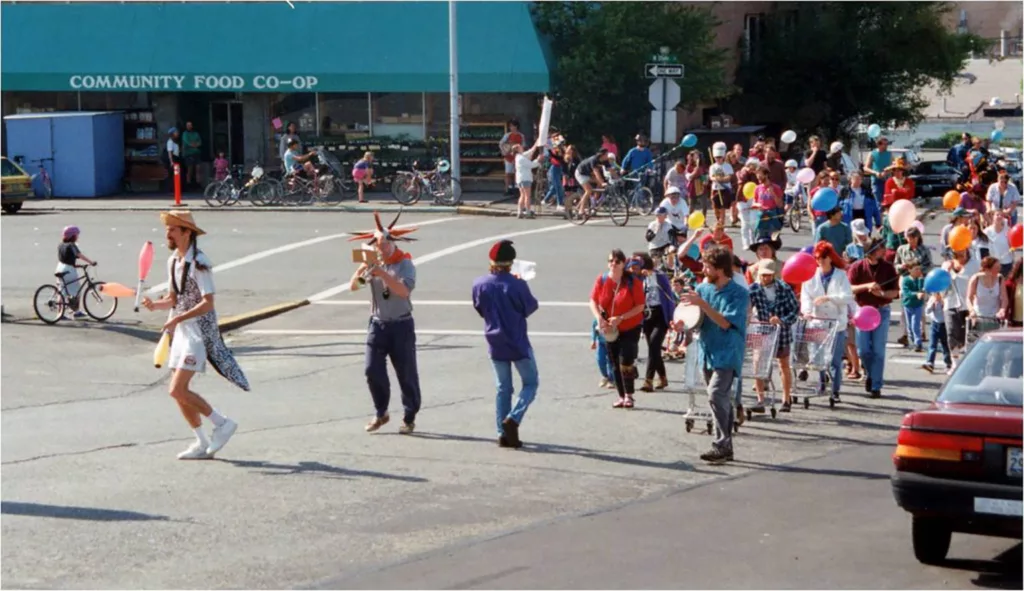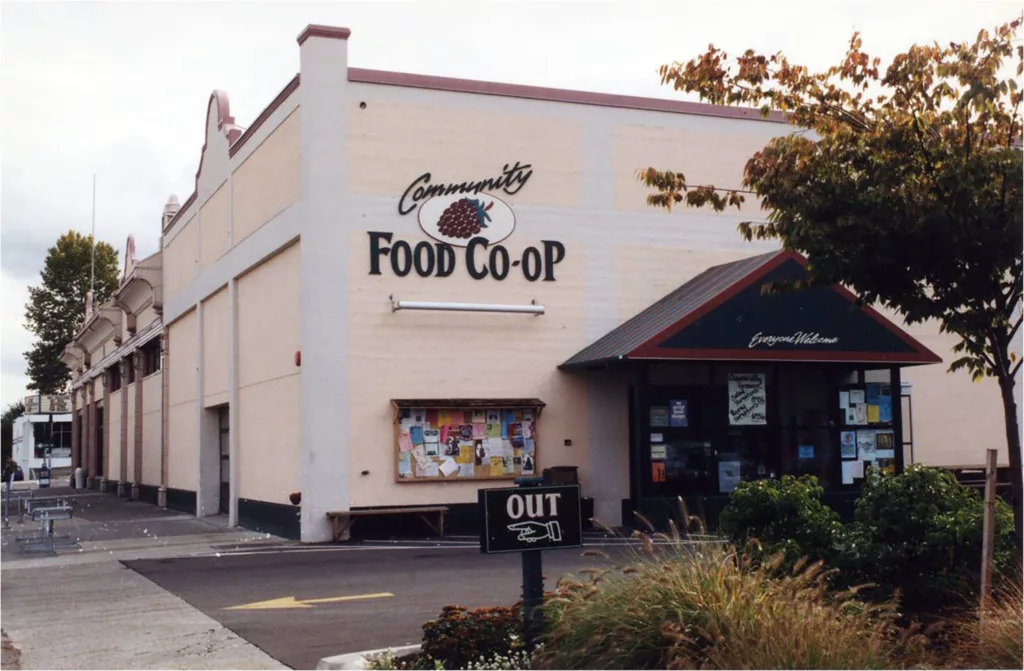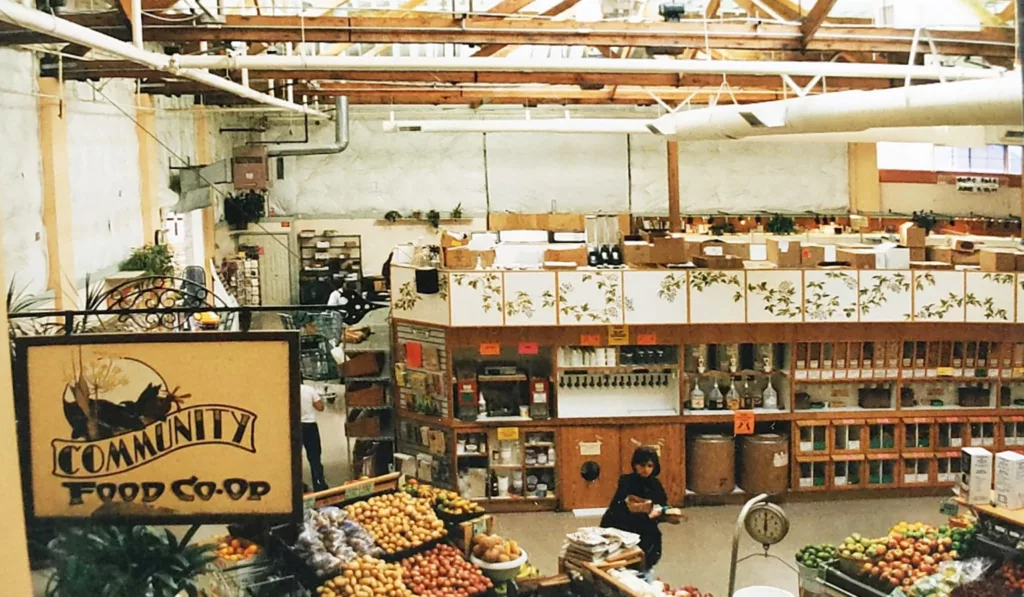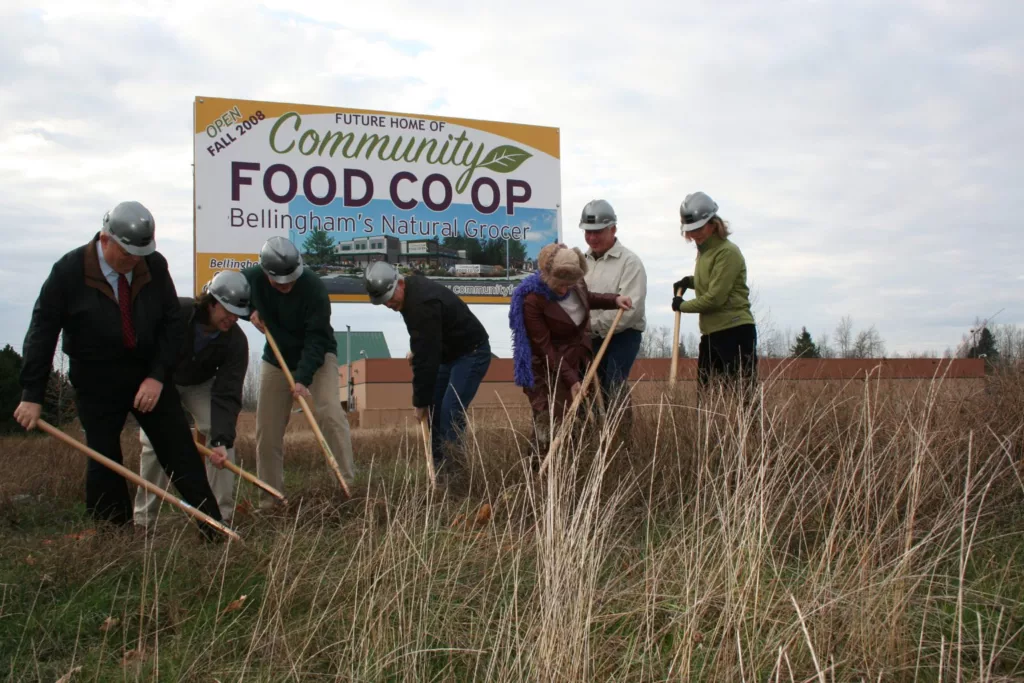
Celebrating 50 Years of Good, Local, Food,
A version of this article appears in the 2021 issue of the Whatcom County Historical Society journal. Look for the journal at Village Books.
Small, Countercultural Beginnings
The Community Food Co-op has its origins in that season of love and change, summer of 1969. Don Alford offered up his tiny little garage and a local food-buying club was born.
This first iteration of the Community Food Co-op in Bellingham only had 10 members, but they worked hard and volunteered their time to source and share a variety of products that were not available in conventional grocery stores of the era: organic raisins, rennetless cheese, and brown rice to name a few.
On the occasion of the co-op’s 25th anniversary, Alford, an active early volunteer, recounted how each week he would drive down to Seattle to pick up a load from wholesalers or Puget Consumers Co-op (now PCC) and drive it back. He explained that the co-op got its produce from California, and reminisced about driving to Oregon to meet the distributor at a truck stop, transferring the goods, and driving home.
For the better part of a year, the club steadily grew as news spread and the demand for natural foods increased membership. During this time, the club hopped between garages, basements, and even a beloved Fairhaven diner, Toad Hall. When the co-op finally opened its doors in the Morgan Block in the heart of Fairhaven in March 1970, membership had grown to 40 strong. That inaugural co-op operated with an all-volunteer staff and boasted just eight items for purchase: cornmeal, bread, honey, flour, rice, rolled wheat, wheat germ, and, of course, granola.
Like many of the co-ops that began in the ’70s and gave birth and succor to the natural foods market, the Community Food Co-op owed its auspicious debut and continued success to the boundless energy of those involved. Dedicated volunteer staff kept overhead low and allowed the Co-op to grow its membership alongside its offerings for many years. But twelve long years later, the Co-op outgrew its 900-square-foot home.
Growing Up Without Growing Old
In October 1982, the Co-op moved to a new 5,000-square-foot store located at 1059 N State St. The move ushered in a period of radical growth and change for the Co-op. The very intimate space in Fairhaven, the modest selection of products, and the small but devoted membership there allowed the Co-op to flourish under collective management and with very little in the way of formal structure. By contrast, the larger State St store meant more space to offer a wider array of products and services but demanded full-time attention to run smoothly.
The natural foods industry skyrocketed in the ’80s—new products entered the market and found their way to the Co-op’s shelves and new shoppers joined the Co-op membership. The Co-op was able to begin making the pivot from a natural and organic specialty store to a full-service natural food grocery store. During the twelve years the Co-op remained on State St, membership rose from 200 to 3,200. All of this prosperity meant that the Co-op had to professionalize its operations to keep pace, without sacrificing the values and charm that made it unique.
As part of the transition to State St, the Co-op bought its first computer, an Apple IIc, and set up its first official membership system. In 1983, Co-op members elected the first nine-member Board of Directors to give the growing membership a new voice and ensure democratic leadership. That same year, the Co-op adopted its official by-laws, which transparently lay out how the Co-op will govern and conduct itself while serving its membership. The volunteer discount program came to an end in July 1984 as the Co-op made the leap from a volunteer workforce to an entirely paid staff.
A year later, in July 1985, the Co-op Board hired their first General Manager, Jim Ashby. Ashby oversaw the creation of the Co-op deli in 1988 and the first sales of beer, wine, and seafood. In May of 1989, the Co-op’s annual sales reached a new highwater mark of $1.5 million, and the Co-op management recognized that the State St store was growing cramped.
When the Co-op celebrated its 20th anniversary in November 1990, annual sales crested $2.2 million. The Co-op needed another new home. The Co-op leadership decided to buy the 15,000-square-foot Swan Building on N Forest St, home to Swan’s Moving & Storage, in December 1990. In the previous hundred years, the building had housed a car dealership, a city bus depot, and an auto mechanic’s shop. The Co-op would try to create the first homey space within its walls.
By all of the conventional metrics, the Co-op was a successful business doing millions of dollars in sales each year. But to local banks, the Co-op was an experimental organization and a dangerous investment. Or so the leadership learned, when they tried to place an offer on the new would-be store. In 1992, a local partnership finally agreed to purchase the building, remodel it, and lease it back to the Co-op for 15 years with the option of extending the lease for an additional 15 years. Co-op members came together and contributed more than $100,000 in loans toward the remodeling project.
Two years later, in May 1994, Karl Meyer—a longtime Co-op member, ardent juggler, and now the Co-op’s Community Affairs Coordinator—led a joyous parade of shoppers from the Co-op’s previous location on State St to the opening-day party at the new store at 1220 N Forest St.

With a footprint two-thirds larger than that of the State St store, the new store allowed Co-op staff to enlarge the produce department, introduce hundreds of new grocery items, install a meat department, and expand deli offerings. The Co-op was able to serve espresso for the first time. The first full year in the store, sales increased by 60 percent.

While preparing for the move the year prior, in the spring of ’93, the Co-op had legally cemented its status as a Washington not-for-profit. While the Co-op had always been community focused—it is in the name—the Co-op leadership had never enshrined its not-for-profit mission in law.
With a newly clarified vision, the leadership redoubled the Co-op’s commitment to community education. A couple years after the launch of the Forest Street store, the business acquired the small optometry office with which it shared the parking lot, converted the space into the Co-op Connections building, and began the Healthy Connections class series. Over the years, the Connections building has been a widely used resource for members and community groups in need of a free or low-cost meeting space.
The Co-op continued to grow throughout the rest of the 90s—often challenging the confines of the small, southwest-facing parking lot—but that in no way meant that the Co-op lost touch with its funky and rebellious roots. Over a single night in 1996, Bellingham was blanketed in three feet of snow. In a testament to the temerity of Co-op employees and members, the Co-op kept its doors open the following day. Customers snowshoed and cross-country skied to the store to do their shopping. If ever the newest embodiment of the Co-op needed a litmus test of its spiritual connection to its crunchy origins, it would certainly have passed.
Entering a New Age
The Co-op entered the new millennium in style with an expansive remodel. The small awning that had graced the front of the store since 1994 was replaced by the larger entryway shoppers use today, a massive mural depicting the natural splendor of Bellingham went up on the same face of the building, and many more quality of life improvements were made inside. The bulk section upgraded to gravity feeders that allowed stock to be replenished from the top—it was big news. 2000 also saw the formation of the Co-op Farm Fund, which uses donations from the Co-op, the Whatcom Community Foundation, and community members to increase the supply of local, sustainable, and organic food by supporting and establishing projects that strengthen the local farming community.

By the end of the year 2000, the Co-op had 120 staff members on the payroll and served almost 9,000 members. The number of staff and members had grown threefold over the past decade, with no signs the Co-op was slowing down. By the mid-2000s, the Forest St store was taxed to its limits. There was never enough parking to accommodate the daily flow of members, now totaling 12,000, and the aisles were packed.
Co-op leaders began collecting member input on constructing a second location to ease the strain on the Downtown store and to offer a more convenient place to shop for members from neighboring towns. After copious debate and thoughtful preparation, the Co-op purchased land in the up-and-coming Cordata neighborhood on the north side of Bellingham. The new building would have dozens of solar panels on the roof to sell green energy back to the grid and offset the cost of powering the stores. Co-op leaders broke ground for the new Cordata location in December 2007—just in time for the Great Recession.

In January 2009, the Co-op opened its second location at 315 Westerly Rd. The 17,000-square-foot, LEED certified building would play host to numerous events for the staff and members to get to know their new neighbors. There were summer barbecues on the patio, art shows in the cafe, and live music events in the aisles. By the end of the year, total sales were up 20 percent over the previous year and almost 200 people were employed by the Co-op. Despite the financial hardship many in the country were facing, the first year at Cordata felt promising.
Unfortunately, excitement alone could not sustain sales throughout the rest of the recession. Sales began to slump as the impacts of the recession rippled through the local economy, and the Co-op leadership faced many hard decisions. Despite the adversity of the era, membership continued to steadily grow. When the Co-op celebrated its 40th anniversary in 2010, it did so with 17,000 members and a gradually improving financial forecast.
As the economy recovered, certain challenges appeared to be here to stay. Once alone in the natural foods marketing channel, co-ops across the country found themselves the victims of their own success. Co-ops popularized natural foods only to find that conventional grocery retailers were beginning to adopt healthier, local, and organic products and fill their shelves with brands that once set co-ops apart. Competing with bigger stores for fewer shopping dollars, the Co-op needed to redifferentiate itself in the market and return even more value to the community.
The Co-op leadership pooled resources from those lean recession years and expanded once more. In the summer of 2015, the Co-op opened the Holly St building across the street from the Downtown Store. Management intended this newest addition to the Co-op family to be a mixed-use building. 405 E Holly St, once an auto parts outlet, became home to a full production bakery that supplies fresh baked goods to both the Downtown and the Cordata store. Alongside the bakery, the Co-op debuted the Bakery Cafe, which offered a cozy space for customers to meet to enjoy espresso drinks, smoothies, or baked goods while sitting inside or out on the patio. The Healthy Connections building found a larger, more beautiful space next to the bakery with a full kitchen to make hosting cooking classes easier. Clearing its former home made room for a much-needed expansion of the Downtown store parking lot. To this day, the Holly St building also houses the Co-op’s administrative offices, which frees up precious space in the stores.
A Hopeful Future
Like many businesses in Bellingham, the Co-op was beginning to flourish again just before the COVID-19 pandemic hit. While the pandemic has transformed the day-to-day at the Co-op quite dramatically in the last couple of years, we are proud of how members and staff have come together to meet the moment in which we find ourselves. Swift action by management stabilized sales after a meteoric rise and steep decline in the early days of the outbreak, and staff have taken on new roles to ensure the safety of everyone in the stores. Despite all that is unprecedented in our time, the Co-op finished out the year of its 50th anniversary pretty strong and with almost 30,000 members.
While it is impossible to foretell what the future holds—in 2022, as much as in 2007—we are hopeful. The Co-op and the world have both changed a lot since 1970, but what made the Co-op successful in the first place has not gone anywhere. We still believe in cooperation, mutual respect, honest information, good food, and running a business that places people over profits. Now financial success allows us to realize our commitments to our community—it is that simple—and we hope to still be serving the community and our members in another 50 years.